#wandering okali
Text

A species of blep from cold steppes. Like most species of furred tetrapods, it keeps its young in a pouch for months until they are hardy enough to run about and eat solid food. It eats lichens, roots and mosses primarily, but is an opportunistic scavenger if those prove scarce. It lives in groups of variable sizes, with complex familial dynamics, but these groups can be spread out over great distances; they communicate by loud bellows that cover long distances despite great winds.
#okali#fantasy#wandering okali#species#art#graphi's things#worldbuilding#speculative biology#specbio#xenofiction#creature design
5K notes
·
View notes
Text
go play the visual novel i made
i just finished a SUPER COOL illustration for it which im gonna hold off posting on too many social media for now but i think it's super pretty so in the meantime. i think i deserve to advertise myself a little once in a while since i literally dedicate most of my thinking power to this
and here a little bit of the art i made for it. i think it deserves to be looked at. but seriously play the game me and my friend spent hours upon hours on it i made an ANIMATED INTRO all by myself!!


#art#my art#vndev#visual novel#indiedev#gamedev#okali#wandering okali#i am always stuck between the feelings of “ough i want people to play it so bad but i dont wanna be annoying by advertising it too much”#but like#fuck it man. literally not a day goes by that i dont draw something for it or code or write#barely an hour goes by that i dont think about the world or the characters#i shouldnt restrain myself from talking about literally my greatest passion
9 notes
·
View notes
Text
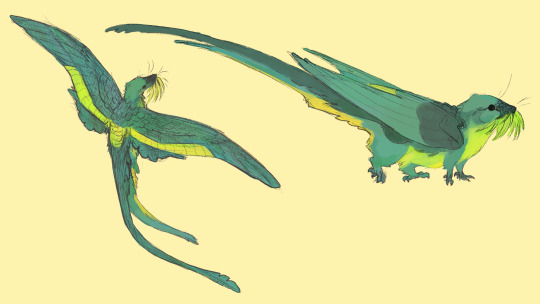
These small kullau are part of a species that lives in large groups, up to thousands of individuals, who fly together throughout the sky to catch small flying bugs that they eat.
They tend to favor wetlands to nest; the abundance of their prey makes it ideal for them. During the period when they raise their young, their fluffy whiskers get even fuller, and those catch and trap extra bugs in them, which helps them get extra food to their babies.
Outside of those periods, a flock travels here and there, mostly following ideal weathers for hunting in the sky. Due to this, seeing them is often a good sign that the next few days will be warm and sunny.
#okali#fantasy#wandering okali#species#art#graphi's things#worldbuilding#speculative biology#specbio#xenobiology#creature design#xenofiction
282 notes
·
View notes
Text
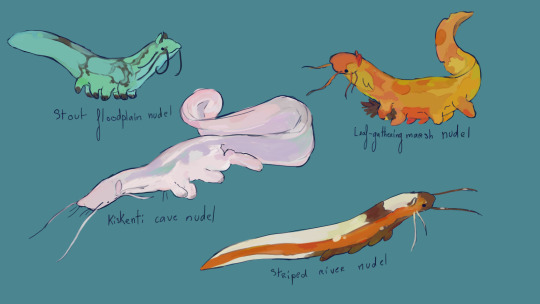
Some various species of nudelu!
The stout floodplain nudel inhabits the rolling hills part of the Nalken area in Omikti's breath. It lays its eggs in large puddles, so that they have plenty of humidity to hatch and grow for their first few days in water, but can do so in water devoid of predators.
The Kiskenti cave nudel is a slow-moving, blind animal, but their whiskers are longer and more sensitive. Due to living in caves where food is scarce, they have the ability to remain unmoving for months, or even years, slowing their metabolism until a prey passes by.
The leaf-gathering marsh nudel is a quick and intelligent creature, that spends less time in water once it can walk, and instead takes to the damp floor of swamps, grabbing and lifting leaves with its two front paws to eat the creatures hiding in the leaf litter.
The striped river nudel, on the other hand, spends almost all of its time within water; a fast swimmer, they appreciate clear, pure waters and can be found high within mountain streams. They can do impressive jumps out of water to catch insects.
#okali#fantasy#wandering okali#species#art#graphi's things#worldbuilding#speculative biology#specbio#xenobiology#creature design#spec bio#speculative zoology#fantasy creature#fantasy worldbuilding#xenofiction
255 notes
·
View notes
Text

The plikelo is a species of kulla that lives in tree hollows and other such crevices. They mostly fly in short bursts, though their hindwings allow them to glide nicely on the hot air currents above some patches of magic-using mushrooms that grow in their habitats, which lets them reach higher trees with little effort. The tip of their muzzle is a hard beak, with which they pierce through the bark of trees before lapping up the sugary sap.
#okali#fantasy#wandering okali#species#art#graphi's things#worldbuilding#speculative biology#specbio#xenobiology#fantasy biology#creature design
200 notes
·
View notes
Text

An esoblep enjoying a tasty snack of nectar, and one trying to gnaw on soap because it just smells so good.
They are a small and fast species of blep, with a keen sense of smell and a curious personality. They are mostly nectivorous but also eat juices from fallen fruit on occasion. Notorious for their ability to get inside houses, a specific breed of Nium exists to lure them back outside. They are desired in fields of crops with large, showy flowers, and are important pollinators for these.
Bonus pic of an old-ish drawing that i somehow never posted on this blog?? oh well

#okali#fantasy#wandering okali#species#art#graphi's things#worldbuilding#speculative biology#specbio#xenobiology#creature design
188 notes
·
View notes
Text

a slight redesign of the Olwo, an ungulate which grows plants on itself. It has large, thick legs to support the weight of the plants, a long tail with fine, long fur, and a vividly colored patch of fur on its throat.
They use the plants growing on them as both camouflage, a source of food, and a way to stock magic. While most hardy enough species will take root in an olwo, some are specialized for this.
Due to the movement of herds, they are an important part of spreading seeds around in the parts of the world where they live.
#okali#fantasy#wandering okali#species#art#graphi's things#worldbuilding#speculative biology#specbio#creature design#xenobiology#xenofiction
181 notes
·
View notes
Text
Eyed worms
Eyed worms are a large and diverse group of invertebrates in Okali. Ranging in size from a couple millimeters to one or two meters, these creatures are often brightly colored.
They are segmented, with the number of sections varying between species, though the most common is 9. Each segment, except the last one, has four eyes, two on each side. They do not form very clear pictures, but are good at detecting fast movements.
They have the ability to secrete a sort of black silk from their saliva, which they use to construct nests out of foraged materials, or cover their egg masses.
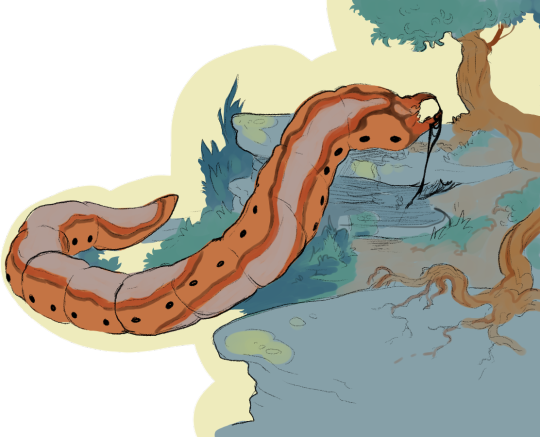
Most species are ground-dwelling or diggers, but they occupy a wide range of habitats, some are arboreal, for example!

Around their mouth, to manipulate objects or their silk, they have a set of agile pincers ending in a little claw. This claw is the one hard part of their body, which can be found and collected after the death of the animal.
Being made of enamel, it is very hard, and often sought after for various uses, such as jewelry or pens!
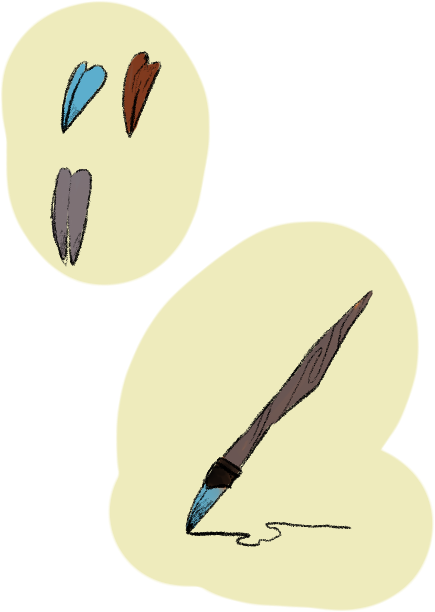
#okali#fantasy#wandering okali#species#art#graphi's things#worldbuilding#speculative biology#specbio#xenobiology#creature design
181 notes
·
View notes
Text

Corals! Everyone's favorite animal!
On Okali, instead of limestone, the skeleton of corals is made of a structure of glass. This gives reefs a beautiful translucid aspect when light shines through them!
This particular species tends to grow in large pillars, sometimes reaching to the surface in such a way that they are out of water during the low tide. They are thus capable of catching small seaside insects in their tentacles as well as the regular waterborne microorganisms. Living, it has a pink and yellow coloration, but its skeleton, while still mostly pink, has an ethereal rainbow sheen to it.
Pieces of polished coral skeletons can sometimes be found on the shore, similarly to how we on Earth find pieces of bottles among the sand. They are often used for jewelry, as they have many colors depending on the species!
#okali#fantasy#wandering okali#species#art#graphi's things#worldbuilding#speculative biology#specbio#xenobiology#xenofiction#creature design#coral
146 notes
·
View notes
Text

the bachi is a small moss-dwelling arthropod, who can conglobate (roll into a little ball) and flies mostly by gliding relying on air currents. acting almost like a seed, it gets transported to other places to find new mates or more food.
#okali#fantasy#wandering okali#species#art#graphi's things#worldbuilding#speculative biology#specbio#xenofiction#creature design#bugs#arthropods
155 notes
·
View notes
Text


redesign of the alikulla! made the second wings bigger to aid the secondaries of the first wings; gotta have some surface to glide on!
ill also try and draw up some of their tack. alikullau are domesticated animals, and often used for transporting people and goods over long, difficult distances, as they are the largest flying animal in the world. While they generally have a mellow and slow demeanor while on the ground, their flight is a sight to see, a beautiful slow glide low over the ground as if magic itself was holding them in the air.
#okali#fantasy#wandering okali#species#art#graphi's things#worldbuilding#speculative biology#specbio#xenofiction#xenobiology#creature design
140 notes
·
View notes
Text

behold
an animal
#okali#fantasy#wandering okali#species#art#graphi's things#worldbuilding#speculative biology#specbio#xenobiology#xenofiction#concept art#creature design#fantasy creature
135 notes
·
View notes
Text
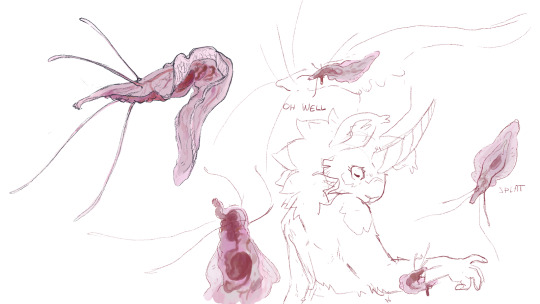
oop, i never did share this to the WO blog. well here is the sleech (ill come up with a better name later).
This animal is a shell-less gastropod that has evolved to drink the blood of larger vertebrates, such as cave nudelu... or the occasional cave explorer. There are many types of it, some living in streams, others in marshes, some even in salty coastal waters! This one in particular, due to being a cave organism, has lost its pigment and appears white most of the time, and pink when it has recently eaten!
They make a small incision with the sharp radula at the end of their elongated snout, and stick on with the large 'skirt' that acts as a suction cup. Their mucus has anti-coagulant properties, and they absorb the nutrients in the blood through a special patch of skin on their underside. Then, after about half an hour, they let go and go digest in peace.
#okali#fantasy#wandering okali#species#art#graphi's things#worldbuilding#speculative biology#specbio#xenobiology#fantasy creature#creature design#creature
89 notes
·
View notes
Text

starting to play around with visuals for a concept ive been having in mind ; travelling storytellers whose costume/outfit serves as a storybook of sorts.
#okali#fantasy#wandering okali#art#graphi's things#worldbuilding#xenofiction#concept art#character design#outfit design
130 notes
·
View notes
Text

The lobuut is a hardy animal that lives in the coastal areas of Omikti's breath. They use their strong paws and large tusks to overturn rocks or dig in the beach to find crustaceans or seashells, which they crush with their powerful molars. It's not all they eat though, they also eat seaweed and are scavengers on occasion, often taking over large carcasses by driving away smaller animals from it. They excel in environments with quicksand, which they have no problem traversing thanks to their thick, heavy tails keeping their weight spread out over a large area.
They are domesticated and used as beasts of burden and livestock within the Rain Ravine. Domesticated lobuutu have smaller horns than their wild counterparts, but keep the large tusks as people have trained them to catch and retrieve crustaceans along the coasts and the riverbanks. Though they are poor swimmers, their heavyset build and ability to hold their breath for a long time lets them traverse waters by trudging along the bottom without needing to truly swim.
#okali#fantasy#wandering okali#species#art#graphi's things#worldbuilding#speculative biology#specbio#xenobiology#creature design#fantasy biology#xenofiction#fantasy creature
37 notes
·
View notes
Text

where it all started!! one of the first concepts for wandering okali had the main character be a kamablep... how far we've come and yet they're still here :3c
#okali#fantasy#wandering okali#species#art#graphi's things#worldbuilding#speculative biology#specbio#creature design#xenobiology#fantasy biology
38 notes
·
View notes